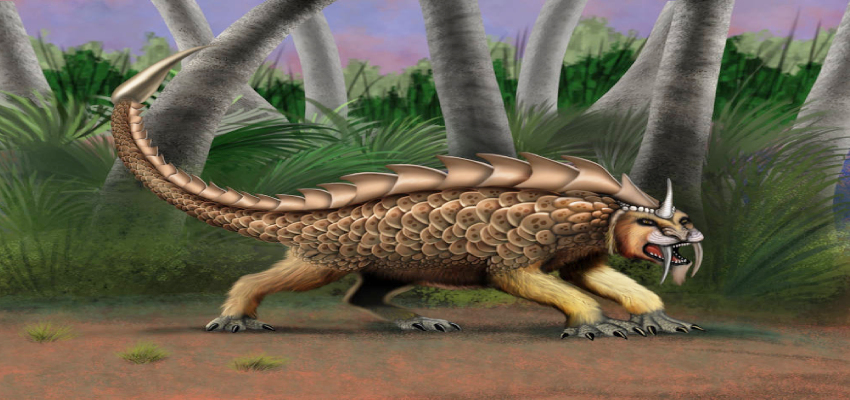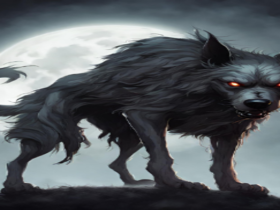The Dingonek is a mythical monster and cryptid said to live in the rivers and swamps of Africa. It is described as having the body of a lion, the head of a crocodile, and sharp, venomous spines running down its back. Some legends also describe it as having webbed feet and a long, flexible tail. The Dingonek is said to be extremely aggressive and dangerous, and is said to prey on both animals and humans. However, there is no scientific evidence to support the existence of such a creature.
1Dingonek Name Was Given To A Monster Who Survived In Rivers Of Southern Kenya

The Dingonek is a creature that is said to live in the rivers of southern Kenya and it is known to the Okiek people. It gained fame due to an alleged sighting by English adventurer John Alfred Jordan. He described it as an aquatic animal with long fangs and covered in plate-like scales. It is considered to be a difficult creature to classify, some experts have considered it as a neodinosaur, others have linked it to a creature called lukwata in Lake Victoria, and some like Bernard Heuvelmans have classified it as a water lion. However, Karl Shuker claims that Jordan insisted on the presence of scales and another similar creature called kumbway, which is reported from the swamps of Liberia.
2There Are Several Similar Version Of Mythical Monster Like Ol-maima & Ndamathia
People who were alive at the time of the original sightings of the Dingonek in 1907 found that similar creatures were known by different names among local people, such as ol-maima and ndamathia. However, the name ol-maima is now used to refer to monitor lizards and pangolins, and there have been no recent reports of the Dingonek.
3John Alfred Jordan Was The First Famous Witness Who Recognized This Creature Near East Africa
John Alfred Jordan, a notorious ivory poacher and adventurer, claimed to have seen a creature called a dingonek in a rarely-visited region of southern British East Africa, near the border with German East Africa. Despite his illegal actions, he gained the respect of the colonial authorities. His account of the creature was published by American big game hunter Edgar Beecher Bronson in his book In Closed Territory, and later in articles in Wide World Magazine and the Daily Mail, as well as posthumous books and published story Elephants and Ivory and The Elephant Stone. The name dingonek was said to have been used by his local followers, one of whom stated to have seen the animal previously.
4Charles William Hobley Later Studied & Documented About This Undiscovered Creatures With Alleged Sightings & Its Existence In Local African Societies
When the tale first spread throughout British East Africa, it was initially thought of as a “traveler’s tale, told to amuse a newcomer,” according to Charles William Hobley, founder of the East Africa and Uganda Natural History Society and former confiscator of stolen specimens from Jordan.
Hobley later learned that a similar animal had been spotted in the Mara River, and when he inquired about the creature with Kisii District Commissioner Dudley Russell Crampton (1882–1947), he learned that the Masai in the area knew it by the name ol-umaina. Hobley also hypothesized a link between the dingonek and the ndamathia, a reptilian creature of the Tana River known to the Kikuyu.
The creature, known to the Kikuyu people, played a significant role in their religion and ceremonies. It was described as having characteristics of a reptile, crocodile, serpent, or dragon, but also featured a hairy tail.
Hobley believed that the legends of the dingonek and lukwata could potentially be evidence of an undiscovered, extinct species of reptile, specifically a “survival of some extinct race of saurians.”
5There Are Chances Monitor Lizards May Be Misunderstood As Dingonek Monster Or Ol-maima

Heuvelmans tasked James Powell, a herpetologist and cryptozoologist, with studying the dingonek during his fieldwork in Kenya in 1978. Three elderly Siria men from Lolgorien, a village close to the Migori, provided Powell with information about the animal and claimed that it was called ol-maima, not ol-umaina, and that the dingonek might turn out to be a dinosaur. Their description reminded them of the giant pangolin (Smutsia gigantea), despite the fact that they associated the ol-maima with Powell’s painting of a Tyrannosaurus. More recent sources claim that monitor lizards are typically referred to as ol-maima, which is “crippled” in Masai.
6Many Physical Characteristics Of Dingonek Differs By Different Witnesses But They Are 12 to 16 ft Long In All Cases

Jordan estimated the length of the Dingonek to be between 14-18 feet (4.2-5.4m), but another witness described it as around 16 feet (4.8m) long. The creature had a broad back covered in overlapping scales like an armadillo and patterned like a leopard.The second witness also said it had spots like a leopard. Jordan initially compared the creature’s massive, flat-skulled and round head with feline ears to that of a leopard, but later described it as otter-like after the second witness described it as such.
Jordan consistently stated that the animal had big, yellow tusks protruding from its upper jaw, similar to those of a walrus, which the second witness didn’t mention. The creature’s tail was broad and “finned” and was used as a rudder.
71907 Sighting By Jordon Published In Several Big Magazines & Newspapers
According to Jordan, he had an encounter with the dingonek in 1907 while moving towards the Migori River. Some of his men who had gone ahead to the river came back, frightened, and told him that they saw a “terrifying strange beast” on the riverbank, which had immediately dived into the water when they had arrived.
Jordan did not believe his men, who described the animal as “a combination of a sea serpent, a leopard, and a whale,” but went down to the river to see it 30 minutes later. The earliest first-hand account of the sighting was published in Wide World Magazine in 1917, and subsequently in several other magazines and newspapers.
The creature had disappeared by the time Jordan returned to the river, but Jordan could still make out its footprints in the squishy mud. They had the impression of large claws and were as wide as hippopotamus teeth. Jordan asked Bronson to discuss the incident with his hunting team after the latter voiced skepticism about the story. Through an interpreter, they all provided similar accounts of the event, according to Bronson.
8According To Animal Collector James Martin, Rarest Dingonek Was Shot Dead By A White Man
Before going on his safari, Bronson had met Charles William Hobley, who had told him about the lukwata of Lake Victoria. According to Hobley, the Baganda, Wasoga, and Kavirondo people who lived on the lake’s northern shore thought the lukwata had just been shot and killed by a white man, which had led to an outbreak of sleeping sickness. The Maltese explorer and animal collector James Martin (1857–1924) later told Bronson about the lukwata. Since the Migori River empties into Lake Victoria, Bronson reasoned that the lukwata that was purportedly shot was the dingonek, a conclusion Jordan eventually came to share.
9Before 1913, Similar Unidentified Creatures Have Been Sighted In The Mara River
Charles William Hobley received another report of an unknown animal, which he linked to the dingonek, from an anonymous person who had reportedly seen it in the Mara River, close to the boundary with German East Africa. Hobley published this account in the Journal of the East Africa and Uganda Natural History Society in 1913.
“He was at a location where the Mara River flooded and crossed the border, and saw a large creature floating down the river on a log. He estimated its length to be around 16 feet, but couldn’t be sure as its tail was in the water. He described it as having a leopard-like spotting, scales, and an otter-like head, but did not see the long fangs mentioned by Mr. Jordan. He shot at it and hit it, and it slid off the log into the water, and was not seen again.”
10Presently We Don’t Know If Dingonek Is Extinct Or Still Surviving In The Riverbanks Of Dense Forests
Despite the lack of recorded sightings since 1907, Jordan reported that local tribes considered it forbidden to kill a dingonek, which Karl Shuker suggests as a positive indication of its possible survival. However, Heuvelmans believed it to be likely extinct, but held hope for the survival of its related species, the water lions.
11Experts Have Always A Question Of Credibility Of Jordan’s Sighting That Makes This Creature A Hoax

Jordan had a reputation for telling tall tales, and his summary of the dingonek was often viewed as such when it became well-known in British East Africa. Heuvelmans ruled out the possibility of it being a hoax because Jordan’s accounts were consistent in the major details, but inconsistent in the minor details such as the size of the animal and the date of the sighting, which Heuvelmans believed indicated that Jordan was neither making it up nor sticking to a predetermined story. However, Karl Shuker points out several more significant inconsistencies in Jordan’s various accounts, which raises questions about the credibility of his sighting.
Jordan initially thought the Dingonek was a reptile but wasn’t sure if it was a descendant of a prehistoric dinosaur or an unclassified reptile/amphibian. Hobley also believed it was a reptile/amphibian. Heuvelmans believed it was more likely a mammal. Jordan’s descriptions of the Dingonek being scaled were compared to an armadillo, which are mammals, rather than reptiles. The Dingonek’s prominent fangs or tusks, not a common reptilian feature, suggest it’s a mammal. The Lukwata, often considered the same as the Dingonek, is more likely to have been a giant catfish or serpentine mammal and not a reptile.
12There Might Be Chances Of Mistaken Sighting Of Giant Pangolins
The description of the ol-maima given to James Powell in 1978 appears to match that of the giant pangolin (Smutsia gigantea), which is described as an aquatic animal that is about 6 feet long with hair-based scales, a long snout, and a long tail. Heuvelmans suggests that it is not unlikely that the Kikuyu people would mistake the giant pangolin for the dingonek, as both are rare and not well-known animals. Another possibility is that the name ol-maima originally referred to a different, now extinct, animal and the Masai people used it to refer to the closest known animal, which is the giant pangolin.
13Water Lions Have Many Physical Similarities With Dingonek
Heuvelmans, who classified the Dingonek as a “water lion”, believed that these tusked aquatic cryptids reported in Africa were sabre-toothed cats adapted to an aquatic lifestyle. He noted that the Dingonek resembled a sabre-toothed cat with its leopard-like head, feline body, and walrus-like tusks (similar to enlarged canines of sabre-toothed cats). He suggested that the tusks may be smaller or absent in some cases, but the Dingonek’s broad tail did not match the short tails seen in other water lions or sabre-toothed cats.
The biggest issue with this theory is the alleged dingonek scale armour. Heuvelmans postulated that if the dingonek were a cat, its “scales” could be defined as an optical illusion brought on by the sun’s shadows falling on its shiny, wet fur, which may have been clumped together by the water. It is possible that the opposite of Jordan’s theory—that the dingonek’s leopard-like spots are actually an optical illusion brought on by the dappled sunlight on its scales—is true.
14Other Theories Relates Dignonek With Kumbway Cryptid
Karl Shuker stated that Jordan was “very insistent” that the Dingonek was scaled based on his first-hand account. Heuvelmans initially proposed that the Dingonek, along with the Mourou-ngou and Lipata, might be a giant crocodile related to the dwarf crocodile (Osteolaemus tetraspis), which has a round, short snout. A similar cryptid called the Kumbway was reported from the swamps of Liberia’s Lofa County. According to American aid worker John-Mark Shephard, the Kumbway was a 15-20 ft quadrupedal mammal covered in brown and black armor with prominent teeth and could rear up bipedally, like the Dingonek.
Karl Shuker stated that Jordan was “very insistent” that the Dingonek was scaled based on his first-hand account. Heuvelmans initially proposed that the Dingonek, along with the Mourou-ngou and Lipata, might be a giant crocodile related to the dwarf crocodile (Osteolaemus tetraspis), which has a round, short snout. A similar cryptid called the Kumbway was reported from the swamps of Liberia’s Lofa County. According to American aid worker John-Mark Shephard, the Kumbway was a 15-20 ft quadrupedal mammal covered in brown and black armor with prominent teeth and could rear up bipedally, like the Dingonek.
References
Heuvelmans, B.; Garnett, R. trans. (1958) On the Track of Unknown Animals. Rupert Hart-Davis, London.
Bryant, A. T. (1948) The Zulu People. Shuter and Shooter, Pietermaritzburg.
Shuker, K. P. N. (1995) In Search of Prehistoric Survivors. Blandford, London.
Stow, G. W. and Bleek, D. F. (1930) Rock-paintings in South Africa. Methuen & Co. Ltd., London.
Bronson, E. B. (1910) In Closed Territory. A. C. McClurg & Co., Chicago.
Conway, J.; Kosemen, C. M.; and Naish, D. (2013) Cryptozoologicon Vol. I. Irregular Books.
Payne, D. L. and Ole-Kotikash, L. (2008) Maa Dictionary. University of Oregon, accessed online.
Oswald, F. (1915) Alone in the Sleeping-Sickness Country. Kegan Paul, Trench, Trubner & Co., London.
Hobley, C. W. (1913) On Some Unidentified Beasts. The Journal of the East Africa and Uganda Natural History Society, III(6), pp. 48-52.





